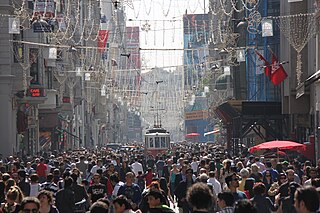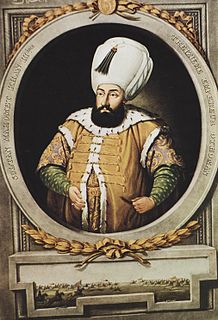
Mehmed III was Sultan of the Ottoman Empire from 1595 until his death in 1603.
Sedefkar Mehmed Agha Biçakçiu or Sedefqar Mehmeti of Elbasan is recorded as the Ottoman architect of the Sultan Ahmed Mosque in Istanbul. He was of Albanian origin.

The Kapi Agha, formally called the Agha of the Gate of Felicity, was the head of the eunuch servants of the Ottoman Seraglio until the late 16th century, when this post was taken over by the Kizlar Agha. In juxtaposition with the latter office, also known as the Chief Black Eunuch as its holders were drawn from Black African slaves, the Kapi Agha is also known as the Chief White Eunuch.

Handan Sultan was the consort of Sultan Mehmed III, and Valide Sultan to their son Sultan Ahmed I.
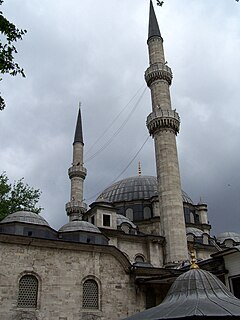
The Eyüp Sultan Mosque is situated in the Eyüp district of Istanbul, outside the city walls near the Golden Horn. The present building dates from the beginning of the 19th century. The mosque complex includes a mausoleum marking the spot where Abu Ayub al-Ansari, the standard-bearer and friend of the Islamic prophet Muhammad, is said to have been buried.

The Yeni Camii, meaning New Mosque; originally named the Valide Sultan Mosque and later New Valide Sultan Mosque after its partial reconstruction and completion between 1660 and 1665; is an Ottoman imperial mosque located in the Eminönü quarter of Istanbul, Turkey. It is situated on the Golden Horn, at the southern end of the Galata Bridge, and is one of the famous architectural landmarks of Istanbul.

The Palace of the Porphyrogenitus, known in Turkish as the Tekfur Sarayı, is a late 13th-century Byzantine palace in the north-western part of the old city of Constantinople. An annex of the greater palace complex of Blachernae, it is the best preserved of the three Byzantine palaces to survive in the city, and one of the few relatively intact examples of late Byzantine secular architecture in the world.

The Turkish and Islamic Arts Museum is a museum located in Sultanahmet Square in Fatih district of Istanbul, Turkey. Constructed in 1524, the building was formerly the palace of Pargalı Ibrahim Pasha, who was the second grand vizier to Suleiman the Magnificent, and was once thought to have been the husband of the Sultan's sister, Hatice Sultan.
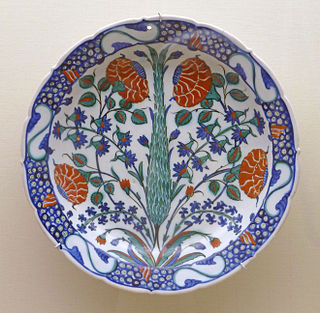
Iznik pottery, or Iznik ware, named after the town of İznik in western Anatolia where it was made, is a decorated ceramic that was produced from the last quarter of the 15th century until the end of the 17th century.

The Teşvikiye Mosque is a neo-baroque structure located in the Teşvikiye neighbourhood of Şişli district in Istanbul, Turkey.
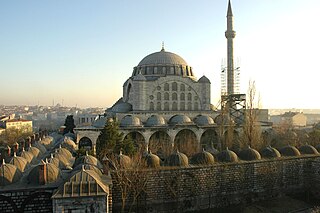
The Mihrimah Sultan Mosque is a 16th century Ottoman mosque located in the Edirnekapı neighborhood near the Byzantine land walls of Istanbul, Turkey. It was commissioned by Mihrimah Sultan, the daughter of Suleiman the Magnificent and designed by the chief imperial architect Mimar Sinan. Sited on the peak of the Sixth Hill near the highest point of the city, the mosque is a prominent landmark in Istanbul.

Hasköy is a quarter (semt) on the northern bank of the Golden Horn in Beyoğlu, Istanbul, Turkey. It includes the officially defined neighborhoods (mahalleler) of Keçeci Piri, Piri Paşa, and Halıcıoğlu, and parts of Camiikebir and Sütlüce.
Kırmızı Minare Mosque is a mosque in the Hasköy neighborhood of Beyoğlu, Istanbul, Turkey. It was probably built in 1591 by Kiremitçi Ahmet Agha and so is also known as the Kiremitçi Ahmet Agha Mosque. It received the name "Red Minaret" because of its red brick minaret. The building was restored in 1889 and 1994.

The Mosque with the Spiral Minaret is a 16th-century Ottoman mosque in Şarachane park, Fatih district, Istanbul, Turkey.
Halime Sultan was a consort of Sultan Mehmed III, and the mother of Sultan Mustafa I and the Valide Sultan as well as a regent of the Ottoman empire. She had four children with Mehmed: Şehzade Mahmud, Mustafa I, and two daughter. She was de facto-co-ruler as Valide Sultan from 22 November 1617 to 26 February 1618 and from 19 May 1622 to 10 September 1623. She is one of powerful woman of the Ottoman Empire. Halime was also one of the eminent figures during the era known as the Sultanate of Women. Halime lived in the Ottoman empire as a courtier during the reign of five Sultans: Murad III, Mehmed III, Ahmed I, Mustafa I, and Osman II.
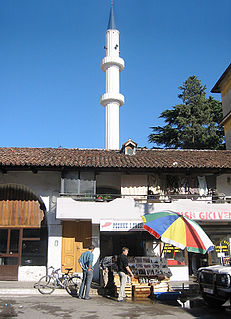
The Mosque of Mahmud Agha Kokonozi or New Bazaar Mosque is an Ottoman-era mosque built in 1750 and one of the few mosques that survived the communist dictatorship under the Hoxhaist regime.

The Haseki Sultan Complex is a 16th-century Ottoman mosque complex in the Fatih district of Istanbul, Turkey. It was the first royal project designed by the chief imperial architect Mimar Sinan.

Veled-i Yaniç Mosque is an Ottoman mosque with the type of early Ottoman architecture. The mosque is located in Bursa and it is still in use. According to the inscription, which is above the entering door, we know that this mosque was built at the July 1440 by Mahmud Çelebi. The mosque is categorized under the title of early Ottoman architecture.
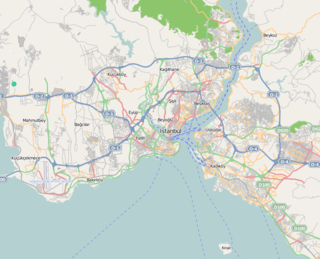
Hırka-i Şerif Mosque is a historic mosque in Istanbul, Turkey. It takes its name from a relic, the blessed mantle of Prophet Muhammad, which is preserved in the mosque.


